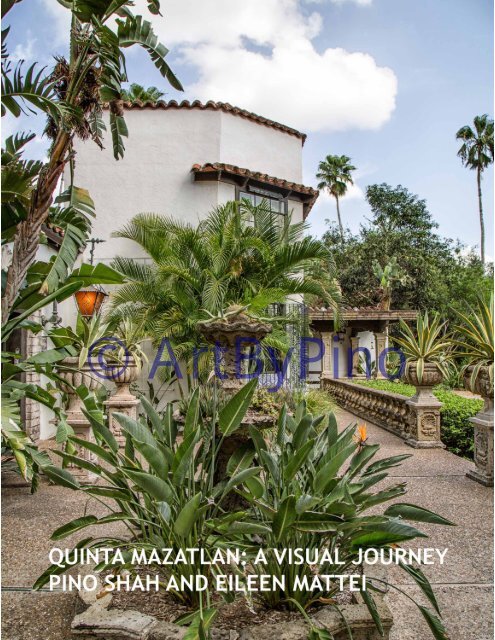Quinta Mazatlan: A Visual Journey
Quinta Mazatlan: A Visual Journey, is a celebration of the architectural and cultural wonders of McAllen’s most distinctive mansion and landscape. Photographer Deval Pino Shah and writer Eileen Mattei collaborated on this book filled with stunning images by Shah. Mattei presents new artistic and historical perspectives of one of Texas’ largest adobe homes and its surrounding environment. Quinta Mazatlan is one of the nine World Birding Centers in the Rio Grande Valley. More than 250 species of birds are attracted to the native habitat, and that brings in birders to see exotic residents such as Kiskadees, Groove-billed Anis and Red-crowned Parrots. Pino Shah is a world heritage photographer based in McAllen, Texas and Ahmedabad, India. A freelance writer based in the Rio Grande Valley, Eileen Mattei writes travel, nature and history articles for Texas Coop Power, Texas Highways, and other magazines. She is the author of At the Crossroads: Harlingen’s First 100 Years; Leading the Way: McAllen’s First 100 Years, and For the Good of My Patients: The History of Medicine in the Rio Grande Valley.
Quinta Mazatlan: A Visual Journey, is a celebration of the architectural and cultural wonders of McAllen’s most distinctive mansion and landscape. Photographer Deval Pino Shah and writer Eileen Mattei collaborated on this book filled with stunning images by Shah. Mattei presents new artistic and historical perspectives of one of Texas’ largest adobe homes and its surrounding environment.
Quinta Mazatlan is one of the nine World Birding Centers in the Rio Grande Valley. More than 250 species of birds are attracted to the native habitat, and that brings in birders to see exotic residents such as Kiskadees, Groove-billed Anis and Red-crowned Parrots.
Pino Shah is a world heritage photographer based in McAllen, Texas and Ahmedabad, India.
A freelance writer based in the Rio Grande Valley, Eileen Mattei writes travel, nature and history articles for Texas Coop Power, Texas Highways, and other magazines. She is the author of At the Crossroads: Harlingen’s First 100 Years; Leading the Way: McAllen’s First 100 Years, and For the Good of My Patients: The History of Medicine in the Rio Grande Valley.
You also want an ePaper? Increase the reach of your titles
YUMPU automatically turns print PDFs into web optimized ePapers that Google loves.
© ArtByPino
The Casa de Azulejos (tiles) in Mexico<br />
reportedly influenced Jason and Marcia<br />
Matthews' design of <strong>Quinta</strong> <strong>Mazatlan</strong>. The<br />
twelve-foot long Roman tub and walls<br />
of blue and white Talavera tile whisper<br />
luxury and relaxation. The cantera stone<br />
was added by the Schultzes.<br />
© ArtByPino
© ArtByPino<br />
Renaissance man Jason Matthews (1887-1964) was<br />
extraordinary, and so is the house he and his adventurous<br />
wife Marcia built on McAllen’s highest elevation and named<br />
<strong>Quinta</strong> <strong>Mazatlan</strong>.<br />
As an explorer, a freedom fighter for indigenous people, a<br />
pioneer in aviation, scriptwriter, composer and storyteller,<br />
Matthews traveled the globe. He considered McAllen the<br />
‘Crossroads of the Western Hemisphere’ and settled there.<br />
Influenced by journeys in Mexico, he designed and built<br />
<strong>Quinta</strong> <strong>Mazatlan</strong> in the late 1930s using more than 10,000<br />
oversize adobe bricks, made on site of local material.<br />
Inside the opulent Spanish Colonial Revival mansion, wide<br />
arches framed in hand-painted Talavera tiles combine<br />
with Saltillo tile floors and dark beams to create grand,<br />
romantic rooms.<br />
Here Matthews conducted hydroponics research, assisted<br />
military bands during World War II and, as a patriotic anticommunist,<br />
published the politically conservative The<br />
(NEW) American Mercury magazine which his wife edited.<br />
Frank Schultz, known as the Grapefruit King, and his wife<br />
Marilyn purchased the abandoned mansion in 1968 and<br />
restored and enhanced it. In 1987 through their efforts,<br />
<strong>Quinta</strong> <strong>Mazatlan</strong> received a historical marker recognizing<br />
it as among the largest adobe homes in Texas.
© ArtByPino<br />
Swiss-born woodcarver Peter Mansbendel, who sculpted the doors at San Antonio’s Spanish Governor’s Place, carved<br />
the mansion’s front door. The two laughing gods were modeled on Jason Matthews, complete with goatee. The cherubs<br />
below represent Matthews’ stepchildren, Edward and Marcia Savage.<br />
The doors’ scallop shells, a symbol of travelers in Europe, also signify Columbus’ three ships. The Schultzes added<br />
the cantera stone frame. Mexican cantera stone is formed of ancient volcanic ash that combined with dirt and shells<br />
and over time were compressed in to soft rock. The porous stone is easily carved.
Seventy feet long and twenty feet wide, the elegant Grand Hall showcases the hacienda’s<br />
signature<br />
©<br />
Saltillo tiles, exposed<br />
ArtByPino<br />
wooden beams, wide arches framed by blue and white Talavera<br />
tiles and walls of oversize adobe brick made on site. On the right before the first arch is the<br />
original front door. The Schultzes installed the three chandeliers.<br />
Invisible behind fireplace<br />
screens, heaters fueled by<br />
free natural gas warmed<br />
<strong>Quinta</strong> <strong>Mazatlan</strong>.<br />
Two gas-burning fireplaces warmed the Grand Hall.<br />
The carved pecan mantle with the signature scallop<br />
shell, the valances and the cantera stone surround<br />
were installed during the Schultz era.<br />
Brass National Electric outlet<br />
embedded in the floor.
A medieval warrior, archer with bow and arrow and heraldic symbols<br />
of a dragon and a rampant unicorn are painted onto leaded glass,<br />
a technique dating to the 16th century.<br />
© ArtByPino<br />
The appearance of paw<br />
prints in air-dried Saltillo<br />
tiles is supposed to bring<br />
good luck.<br />
During renovations, the Schultzes made their marks in<br />
wet cement. Karen Schultz was the daughter and Stephen<br />
the son.<br />
In-floor safe in the former<br />
bedroom closet which was<br />
preserved by the City upon<br />
renovation.
© ArtByPino<br />
Cedar Hall is named for the cedar roof beams, reportedly a gift<br />
from the King of Lebanon for Matthews' service during World War<br />
I. The wide passageway offers three seating areas, a piano and<br />
a shell-shaped fireplace.
Displayed outside the Puebla Room, the<br />
cockfight mosaic vibrates with life using only<br />
five traditional Talavera colors.<br />
Uriarte’s Mexican Folk Art series depicts scenes of daily life. Las<br />
Quekas is the name given to the tile with the tortilla maker. The<br />
Uriarte hallmark is visible in the lower right corners.<br />
© ArtByPino<br />
Talavera’s traditional blue and white tiles with yellow accents feature primarily geometric<br />
and floral motifs. Some styles reflect the influence of Arabic and Mediterranean cultures while<br />
others echo designs of fifteenth century Spain.
Eye-popping folk art in paper, ceramics, wood, metals, and textiles results from<br />
the blending of pre-Hispanic traditions with European cultures and techniques.<br />
The willowy, well-dressed skeleton Catrina, sugar skulls, and skeletons (calaveras)<br />
at Last Suppers characterize the Mexican view of death as something to joke about<br />
and be comfortable with, since it is unavoidable. The dead return on Dia de Los<br />
Muertos to eat the food and smell the flowers left by those who remember them.<br />
© ArtByPino<br />
The Folk Art Room's eye-popping collection of 1,400 magical, mythical<br />
and religious objects and figurines from Mexico flood the senses with<br />
color and craft. Ann Moore donated her collection of wood, clay, paper<br />
and tin folk art, which is displayed in the former bedroom of the<br />
Schultzes' son.
© ArtByPino<br />
The well at <strong>Quinta</strong> <strong>Mazatlan</strong> was used to fill the swimming pool and provide water for the<br />
house. The Schultzes planted Washingtonia palms in the courtyard.
© ArtByPino<br />
Iron gates on exterior doors and the patio entrances made <strong>Quinta</strong><br />
<strong>Mazatlan</strong> a mini-fortress on a hill. The rise marked a natural gas<br />
dome that supplied the mansion with free natural gas for 50 years.
A dry patch of ground provides habitat<br />
for three species of cactus.<br />
Native vegetation - prickly pears and<br />
agaves - reclaims a concrete irrigation<br />
channel that moved water to the citrus<br />
groves and fields near <strong>Quinta</strong> <strong>Mazatlan</strong>.<br />
Ruby Pond, named for one of <strong>Quinta</strong>’s generous donors, provides habitat for frogs, insects and a bronze great Blue Heron.<br />
© ArtByPino
On the Forest Trail, this Texas horned lizard sculpture and dozens of other bronzes alert visitors to the wildlife that thrives<br />
in the border region. Doug Clark’s sculptures of Mexican free-tailed bats, owls, deer, a javelina family and more blend<br />
into the landscape.<br />
© ArtByPino
© ArtByPino<br />
Wide trails wind past thickets of night-blooming<br />
cactus to shady patches created by thorn scrub<br />
trees such as anacua, with its sandpapery-leaves,<br />
husiaches and mesquites.
Black-belled Whistling-Duck<br />
Dragonfly<br />
Sharp-shinned Hawk<br />
Javelina<br />
WILDLIFE IMAGES BY KATHY DETWEILER<br />
© ArtByPino<br />
Chachalaca<br />
Buff-bellied Hummingbird<br />
Bobcat<br />
Zebra Heliconian butterfly






